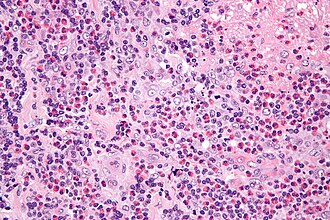Kimura disease
Jump to navigation
Jump to search
| Kimura disease | |
|---|---|
| Diagnosis in short | |
 Kimura disease. H&E stain. | |
|
| |
| LM | eosinophils and thickened walled blood vessels with hobnailed endothelial cells |
| LM DDx | angiolymphoid hyperplasia with eosinophilia, drug reaction, infection (parasitic), lymphoma |
| Site | lymph node, head and neck |
|
| |
| Prevalence | extremely rare |
| Blood work | eosinophilia |
Kimura disease is a rare disease with abundant eosinophils. It may show-up in a lymph node specimen. It is similar to angiolymphoid hyperplasia with eosinophilia.[1]
General
- AKA eosinophilic lymphogranuloma, Kimura disease.
- Chronic inflammatory disorder - suspected to be infectious.
Clinical:
- Usually neck, periauricular.
- Peripheral blood eosinophilia.
- Increased blood IgE.
Epidemiology
- Males > females.
- Young.
- Asian.
Microscopic
Features:[2]
- Angiolymphoid proliferation.
- Thick walled blood vessels with (plump) hobnail endothelial cells.[3]
- Eosinophils - abundant - key feature.
DDx:
- Drug reaction.
- Parasitic infection.
- Angiolymphoid hyperplasia with eosinophilia.
Notes:
- In a lymph node... it may be signed-out as reactive lymphadenitis with follicular hyperplasia and prominent eosinophils, see comment.
- Abundant eosinophils: consider Langerhans cell histiocytosis.
Images
IHC
- Used to rule-out a clonal population, i.e. lymphoma.
See also
References
- ↑ URL: http://emedicine.medscape.com/article/1082603-overview. Accessed on: 14 January 2012.
- ↑ Ioachim, Harry L; Medeiros, L. Jeffrey (2008). Ioachim's Lymph Node Pathology (4th ed.). Lippincott Williams & Wilkins. pp. 190. ISBN 978-0781775960.
- ↑ URL: http://emedicine.medscape.com/article/1098777-diagnosis. Accessed on: 8 August 2010.


